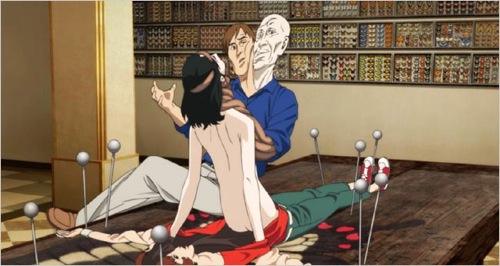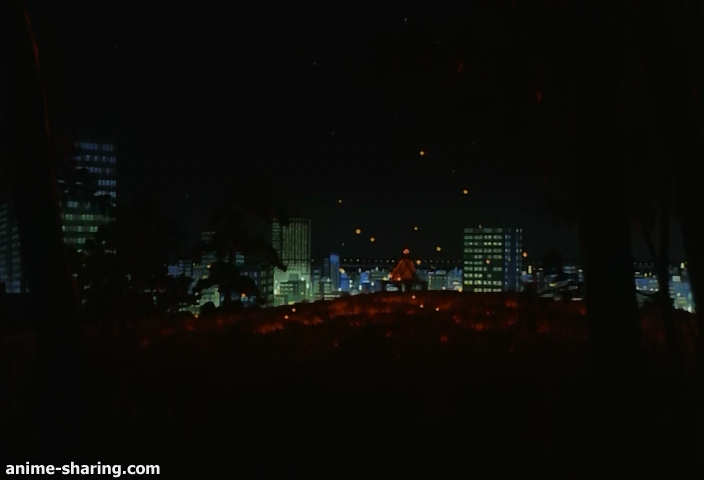I was thrilled to see this movie again for this class because it has been an influential film for me ever since its release in 2006. One of my friends who was/is also a lover of anime suggested I see it and I did. Given that I was still a very young viewer of anime in general I was very confused by this film to say the least. After watching it again and again over the years I’ve slowly come to understand it more and more but it has been a difficult process; the first time I saw it I merely accepted it as being one crazy film.
Now, after having seasoned myself quite a bit more in reading narrative and structure, I feel like I have much greater insight in reading this film. For the purposes of this entry I want to focus on gender interactions and the fantasies of the characters as they play out in the film. To say that gender and sexual desire is at the heart of this film is an understatement, for sure. What we eventually end up seeing in this film is that the primary forces driving the plot are various masculine dreams acting themselves out in pursuit of Paprika/Chiba or for control of the D.C. Minis (the keys to the dream world).
So how do I approach explaining these matters? Well, let’s just talk about the characters and see where we end up.
Tokita and Shimura are two male characters who are actually the least driven by selfish desires for power. Tokita is actually a “pure” character who is described as being a child trapped in the body of a genius. This is mentioned by Shimura who is an old scientist that seems to have a jovial or carefree personality – he always seems like a pretty nice guy! He only does crazy things when he is under control of the D.C. Minis. At one point he jumps out a damned window and later kisses Chiba while seemingly acting out Detective Konakawa’s in-dream actions. Tokita, of course, is Chiba’s true romantic interest but we’ll get to that later.
Chiba and Paprika are the same person. Paprika is Chiba’s alter-ego whom she takes the form of while operating in dreams using the D.C. Mini. The film treats Paprika as Chiba’s suppressed inner-self most of the time. At one point Chiba laments her lack of sleep and Paprika asks her if she’d like her to analyze her dreams. During their conversation Paprika raises the question to Chiba, “Have you ever thought that maybe you are a part of me?” This ‘calls to the fore’ a frightening dilemma:
Is our waking self only a fraction of our subconscious self?
Ultimately, there are no clear answers given.
Another point where the difference between the two is highlighted is when Paprika wants to chase down the Chairman, towards the end of the film, and she ends up arguing with Chiba who wants to stay with Tokita. Chiba desires the love and comfort of another while Paprika is a free spirit who doesn’t share loyalties with any specific person aside from Chiba.
Detective Konakawa is our main male focus in the film and has the most obvious romantic desires for Chiba/Paprika. He is treated for his recurring nightmare by Paprika and seems to be attracted to her when we first meet him with Paprika in a hotel room (in a dream). Later, he meets Chiba when he is assigned to speak with the faculty of the psychotherapy institute because of their workers committing acts of violence and insanity.
Personally, I see Konakawa as being the most admirable of the male characters because he is in love with Paprika/Chiba – just like Osanai – but he takes a totally different approach. He restrains his desires and engages with Paprika in a friendly, respectful, and sometimes shy manner. He doesn’t try to impose his desires on her, despite sometimes getting carried away with his fantasies.
When the parade invades his dreams and Paprika fails to grab the attention of Tokita, Paprika turns around to find Konakawa engaging in risqué behavior with a mannequin. It wouldn’t be much of a jump to assume that he thought that the mannequin was Paprika. Additionally, when Konakawa saves Chiba from the clutches of Osanai and The Chairman, Konakawa embraces Chiba in one arm, blows the smoke off his gun on the other, and then smooches Chiba. I don’t think this is so much Konakawa being a selfish maniac as it was that he got caught up in the plotline of his film’s story and just kept going with the flow because he was feeling FANTASTIC! A very funny scene.
Finally, here we have the two “evil” antagonists of the film. Osanai is a young scientist who is jealous of Tokita’s achievements, wants Chiba to himself whether she likes him or not, and acts as The Chairman’s lapdog. He presumably performed sexual favors for The Chairman and Himuro in the process of securing the stolen D.C. Minis for The Chairman. He sacrifices everything, even his dignity, in his pursuit of Chiba and Paprika. The Chairman is a cripple and a psychotherapy purist who claims that the sanctity of dreams should not be intruded upon by technology. Ultimately, he ends up being a hypocrite and uses the D.C. Minis to recreate himself as the ‘God’ of the dream world.
Osanai and The Chairman are two polarized embodiments of the pursuit for ultimate power over the two most sought after commodities of corrupt hetero-masculine men throughout history: the female and the human race at large. Osanai is enticed by the powerful and intelligent Chiba/Paprika. He likely sees her as the ultimate woman to dominate because if he could dominate her then he surely dominates all women. The Chairman seeks to impose his belief system on the world. He occupies the highest seat of power at the psychotherapy institute but, as a man obsessed with power and authority, he wishes to preside not just over the institute but the dreams of the entire world.
The picture above is definitely a fantastic representation of how nightmarishly ugly the selfish hetero-masculine desire can be. At various points throughout my life, having succumb to such insecurities myself, it isn’t hard to understand how the jealous and conflicting feelings of an incomplete man can act as constricting tree roots to crush and suck the life out of a beautiful woman.
So what happens at the end of this movie? How do these horribly insecure and confusing personal problems play out? Well, this is where interpretation is really important when approaching Paprika. This is what I saw happening when Konakawa defeats Osanai and Chiba/Paprika defeats The Chairman. I believe it was the prevailing of admirable intentions over corrupt ones.
When Osanai and The Chairman are fighting over Chiba’s body, Konakawa arrives to save the day. Why does Konakawa deserve to save the day? Because his love for Chiba/Paprika was sincere and had good intentions. He never knew that Chiba was in love with Tokita and neither did the audience, as well. At the end of the film, he walks away from the institute disappointed that he didn’t get to be with Chiba but he doesn’t throw a fit when he is informed that Chiba is changing her last name from Atsuko to Tokita. He smiles because she is happy. This is why he had the character to save the day and had the honor of stealing a smooch from Chiba.
I think that the story highlights the ability "let go" as a virtue to aspire to. I know that, when I was a kid, I read a children’s book about another kid who raised butterfly larvae as a school project. The story ends with the butterfly hatching from its cocoon and needing to be released into the world. The child cries and gets upset that he/she needs to let it go but the moral of the story is this: “If you truly love something, then you need to have the heart to let it go.”
This movies speaks directly to this moral.
This also brings us back to the story of Madam Butterfly.
The Madam Butterfly storyline has a much more pessimistic approach to the male desire. In the play:
"Cio-Cio-San fears that the Western man who catches a butterfly will pierce its heart with a needle, then leave it to perish."
Osanai acts out this allusion, literally, in the film. His unquenchable thirst for beautiful butterflies to kill and display for his amusement is represented by his own dream sanctuary. His lair is a room filled with pinned butterflies covering the walls behind glass and his way of traveling through dreams is to transform into massive cloud of rampaging butterflies. This speaks to his motivation being fueled by the desire for more butterflies – or, in other words, susceptible women.
The final conclusion to the conflicts in the film, the battle between Chiba and The Chairman, asserts what appear as ambiguous statements about gender relationships. Paprika lists off polar opposites such as good+evil, life+death, and man+woman before retreating to Chiba inside Tokita’s body. She and Chiba become one inside of his body and a baby form of Chiba exits Tokita’s belly. In this way, the female savior is born from her unity with her romantic lover. Paprika and Chiba required the assistance of a man in order to realize themselves as one. Also, Chiba's defeat of The Chairman seems to speak to the conventional Taoist yin and yang approach to gender – especially since Chiba is colored white when The Chairman is colored black.
Personally, I saw her conquering of The Chairman as saying that what really proves a male or female as being superior to the other is how complete one is in terms of "self actualization" as compared to the other. I apologize, that was a horrible sentence. Essentially, Chiba had reconciled with her internal struggles between herself and Paprika. On the other hand, The Chairman was still acting out in a blind rage driven by his lust for power. His blind ambition reveals him to be insecure and acting out of a kind of weakness. Chiba uses her courage lent to her from Paprika and her dichotomy with The Chairman both in terms of gender and workplace status to usurp him and dispose of him - this reveals him to be an unnecessary inconvenience standing in the way of Chiba and Tokita's occupational and romantic dreams.
In doing so, she becomes the master of her own life’s direction, her work’s direction, and her love life. She conquers the dreams of petty, insecure men and becomes a fully realized woman – presumably continuing her work with Tokita and living happily-ever-after in an unorthodox relationship with Tokita.
I think that this film did an AMAZING job of taking a mind-numbingly confusing subject – the insecure male dreams coupled with female subservience – and resolves them in a powerful way. It takes these issues, which are largely prevalent in society today, toys with them and creates a head-reeling adventure. One that concludes by saying that people and relationships come in all shapes and sizes but what really matters is knowing yourself and what makes you happy. Being an English major who is constantly struggling with these issues, I could not love this movie more.














